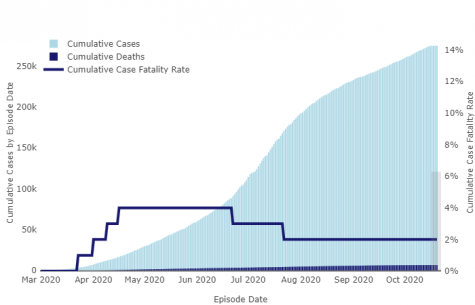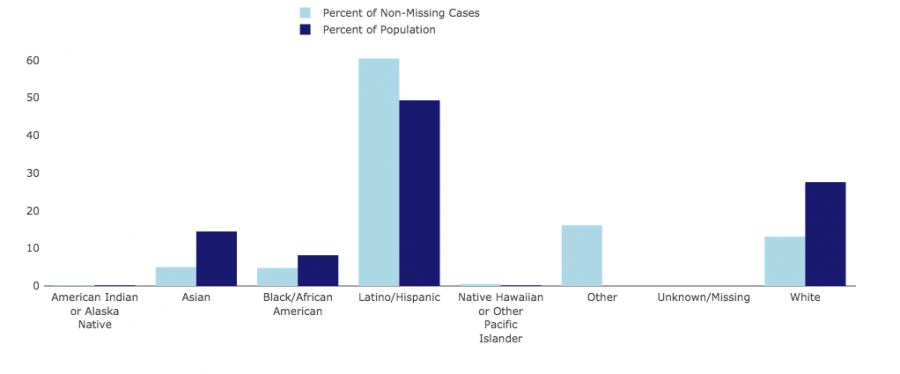COVID-19 Update: Mortality rate decreasing among Latino and Black communities
October 23, 2020
Los Angeles County has the highest number of cumulative cases in the United States, while multiple other counties in California see a rise in the number of cases per capita.
The Centers for Disease Control and Prevention forecasts an upward trend in the number of deaths nationwide. L.A. County currently holds the record for the most confirmed cases in the nation.
We have compiled data and guidance from the Los Angeles County Department of Public Health to provide an update for L.A. County. Data is up to date as of Oct. 23. Here is your weekly COVID-19 update.
Total cases:

Since the first confirmed case of COVID-19 in L.A. County on Jan. 26, the number of positive cases continues to rise. Over 2% of L.A. County’s population of 10 million has had COVID-19.

Hospitalizations:
There are 770 COVID-19 positive patients currently hospitalized in L.A. County. There are 227 COVID-19 positive patients in the Intensive Care Unit. The County currently has 794 available ICU beds.
Race and ethnicity:
L.A. County’s data show cases and deaths disproportionately affect people of color.
The L.A. County Department of Public Health reported that Latinos make up 60.3% of cases with data on race and ethnicity compared to the population, while the white population accounts for 13.1% of cases compared to the population.
Latinos account for 51.5% of all COVID-19 deaths when compared to the population.
Local official updates:
Mortality rate decreasing among Latino and Black communities
The death rate gap between the white community and the Latino and Black communities is closing, according to an L.A. County update on Wednesday.
Barbara Ferrer, the director of L.A. County Public Health, said the Latino community saw six deaths per 100,000 in July, which has since decreased to 1.3 deaths per 100,000 as of Oct. 11. July’s number was four times the rate of white residents at that time.
Four deaths per 100,000 Black residents were reported in July and as of October, less than one death per 100,000 was reported. July’s number was almost three times the death rate of white residents.
“Black residents currently have the lowest mortality rate in L.A. County,” Ferrer said.
There is a decrease in hospitalizations amongst the Black community, but the hospitalization rate still remains high among the Latino community, according to Ferrer.
Schools can reopen at 25% capacity for TK-2 students
As of Wednesday, elementary schools in L.A. County can reopen at 25% capacity. Children with disabilities and students learning English will receive priority for getting back to in-person learning.
The County previously allowed 10% of the county’s most vulnerable students back to in-person learning in elementary schools, according to L.A. County Board Supervisor Kathryn Barger.
“We will now increase to 25% capacity for high needs students, so more children and youth can have access to their teachers and the on-site support system that is so critical for their growth and for their education,” Barger said.
Ferrer said that 986 schools have reopened for high-needs students as of Monday. 110 school waiver applications have been sent in to the L.A. County Department of Public Health and are awaiting approval. Four waivers for private schools have been approved.
County numbers skewed with technical issues
County data reporting systems have experienced significant technical issues affecting case reporting and positivity rate, Ferrer said in Wednesday’s press conference.
Data from Tuesday and Wednesday are likely to be an undercount of the County’s actual total cases.
“We are hopeful that we will be able to resolve the data delays, so by the end of this week we’re able to both fix the numbers for the entire week but also move forward with more accurate counts every day,” Ferrer said.
State issues amusement park reopening guidelines
The state released reopening guidelines for amusement parks on Tuesday. Reopenings are based on the risk level of the county where the park is operating. Parks in counties that are on either the purple or red tier may not reopen.
Counties in the orange tier may reopen at 25% capacity or 500 people — whichever is fewer. Outdoor attractions may operate, but indoor operations must remain closed.
When counties in the orange tier may reopen, ticket sales are limited only to people residing in that county.
At the yellow tier, both indoor and outdoor operations may reopen, but the park’s capacity is still limited to 25%.
Universal Studios Hollywood remains closed as L.A. County is in the purple tier.
Disneyland and Knott’s Berry Farm remain closed as Orange County is in the red tier. Shopping and outdoor dining at City Walk and Downtown Disney and an outdoor event at Knott’s Berry Farm are operating on a limited basis.
What’s open:
Grocery stores
Essential retail
Some non-essential retail with modifications
Parks and beaches with modifications
Golf courses
Hotels with modifications
Shared residential pools
Nail salons – limited to 25% capacity
Hair salons – limited to 25% capacity
Barber shops – limited to 25% capacity
Gyms (outdoors with modifications)
Indoor shopping malls – limited to 25% capacity
Breweries
Wineries
Cardrooms
Zoos (outdoors with modifications)
What’s closed:
Indoor dining at restaurants
Indoor houses of worship
Indoor gyms
Bars
Tattoo shops
Face masks are still required in public. Gatherings should be limited to only people in your household.
Testing:
The L.A. County website has a list of testing locations available for both walk-up and drive-up testing. Testing is available by appointment only.
A comprehensive map of testing locations can be found here.
